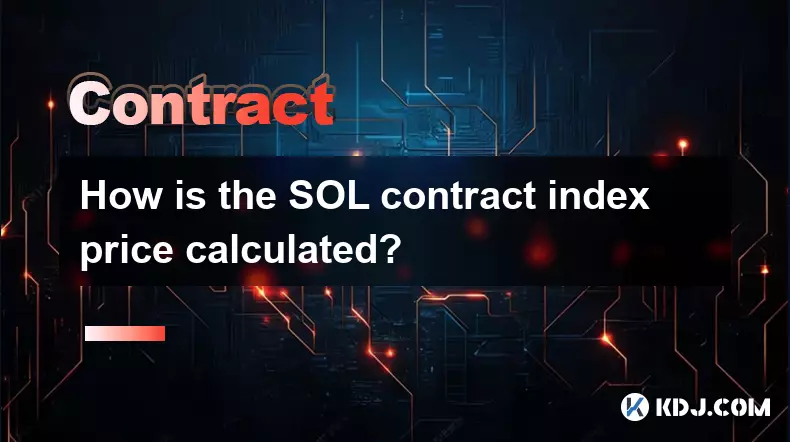-
 bitcoin
bitcoin $122288.232522 USD
0.16% -
 ethereum
ethereum $4480.662914 USD
-0.22% -
 xrp
xrp $2.962747 USD
-2.32% -
 tether
tether $1.000120 USD
-0.05% -
 bnb
bnb $1145.654223 USD
-2.07% -
 solana
solana $227.105217 USD
-1.67% -
 usd-coin
usd-coin $0.999548 USD
-0.02% -
 dogecoin
dogecoin $0.250875 USD
-2.04% -
 tron
tron $0.340654 USD
-0.49% -
 cardano
cardano $0.837968 USD
-2.52% -
 hyperliquid
hyperliquid $48.960449 USD
0.06% -
 chainlink
chainlink $22.049280 USD
-1.33% -
 ethena-usde
ethena-usde $1.000404 USD
0.02% -
 sui
sui $3.586212 USD
0.20% -
 avalanche
avalanche $29.894916 USD
-4.18%
How is the SOL contract index price calculated?
The SOL contract index price is a volume-weighted, real-time average from major exchanges, filtered for outliers and delivered via decentralized oracles to ensure accuracy and resist manipulation.
Sep 25, 2025 at 02:18 pm

Understanding the SOL Contract Index Price Mechanism
1. The index price for Solana (SOL) contracts is derived from a weighted average of prices across multiple reputable cryptocurrency exchanges. This approach ensures that no single exchange can disproportionately influence the valuation, reducing the risk of manipulation. Exchanges included in the calculation typically have high trading volumes and strong security protocols.
2. Data aggregation occurs at regular intervals, often every few seconds, to maintain real-time accuracy. The system pulls the latest bid and ask prices from each contributing exchange and applies a weighting factor based on trading volume. Higher-volume exchanges carry more significance in the final computation, enhancing reliability.
3. Before inclusion in the index, outlier prices are filtered using statistical methods such as median selection or trimming extreme values. This prevents flash crashes or erroneous trades on any one platform from skewing the overall index. Only stable and verified data points are used in the final average.
4. The calculated index price is then fed into decentralized oracle networks, which relay it securely to smart contracts governing futures, perpetual swaps, or options on Solana-based derivatives platforms. These oracles ensure transparency and tamper resistance by sourcing data from multiple independent nodes.
5. Some platforms implement time-weighted average pricing (TWAP) over short intervals to further smooth volatility. This helps prevent sudden price movements from triggering unwarranted liquidations in leveraged positions, offering greater stability during periods of high market activity.
Role of Oracles in SOL Price Feeds
1. Decentralized oracles serve as intermediaries between off-chain market data and on-chain smart contracts. For SOL-based financial instruments, these oracles pull raw price data from APIs of major exchanges like Binance, Coinbase, Kraken, and Bybit, ensuring broad market representation.
2. To maintain integrity, oracle networks often use consensus mechanisms where multiple node operators submit price observations. If submissions fall within an acceptable range, the median value is accepted. Discrepancies trigger validation processes to identify potentially faulty or malicious reports.
3. Oracle updates are timestamped and recorded on the blockchain, enabling full auditability. Users can verify when the last update occurred and assess potential delays during network congestion, which is crucial for risk management in fast-moving markets.
4. Some advanced oracle systems incorporate cryptographic proofs to guarantee data authenticity. These proofs confirm that the price originated from a legitimate exchange API and hasn’t been altered during transmission, strengthening trust in the index price.
5. In cases of extreme volatility or exchange downtime, fallback mechanisms activate. These may include switching to alternative data sources or using previously validated prices with decay adjustments to avoid abrupt disruptions in contract execution.
Influence of Market Conditions on Index Accuracy
1. During periods of high volatility, such as macroeconomic announcements or major project launches, price discrepancies between exchanges can widen temporarily. The index calculation adjusts dynamically by increasing the frequency of data sampling to capture rapid shifts accurately.
2. Network congestion on Solana itself can delay oracle updates, potentially causing temporary divergence between the index price and actual market levels. Platforms mitigate this by setting tolerance thresholds and implementing circuit breakers to pause trading if deviations exceed safe limits.
3. Arbitrage activity plays a key role in aligning prices across exchanges. When significant gaps appear, traders exploit them, bringing valuations back into equilibrium. This natural market force supports the consistency of the index by minimizing prolonged disparities.
4. Exchange-specific factors like withdrawal suspensions or API outages are monitored in real time. Affected platforms are either excluded temporarily from the index calculation or their weight is reduced until normal operations resume, preserving data integrity.
5. The robustness of the SOL contract index relies heavily on continuous monitoring, redundancy in data sources, and adaptive algorithms that respond to changing market dynamics without human intervention.
Common Questions About SOL Index Pricing
What exchanges are typically used to calculate the SOL index price?Major exchanges including Binance, Coinbase, Kraken, Bybit, and KuCoin are commonly integrated into index calculations due to their liquidity and regulatory compliance. The exact list varies by platform but focuses on those with consistent uptime and verifiable trade history.
How often is the SOL index price updated?Updates occur every 5 to 15 seconds depending on the oracle provider and network conditions. High-frequency updates ensure minimal lag between real-world price movements and on-chain representations, critical for active trading environments.
Can the SOL index price be manipulated?While theoretically possible, practical manipulation is highly unlikely due to multi-source verification, outlier filtering, and decentralized oracle architecture. Coordinated attacks across several top-tier exchanges simultaneously would be required, making such attempts costly and easily detectable.
Why does the index price sometimes differ from what I see on my exchange?Individual exchanges reflect local supply and demand, while the index represents a broader market average. Differences arise from latency, regional trading patterns, or isolated order book imbalances. The index prioritizes stability over mirroring momentary spot fluctuations.
Disclaimer:info@kdj.com
The information provided is not trading advice. kdj.com does not assume any responsibility for any investments made based on the information provided in this article. Cryptocurrencies are highly volatile and it is highly recommended that you invest with caution after thorough research!
If you believe that the content used on this website infringes your copyright, please contact us immediately (info@kdj.com) and we will delete it promptly.
- BlockDAG, DOGE, HYPE Sponsorship: Crypto Trends Shaping 2025
- 2025-10-01 00:25:13
- Deutsche Börse and Circle: A StableCoin Adoption Powerhouse in Europe
- 2025-10-01 00:25:13
- BlockDAG's Presale Buzz: Is It the Crypto to Watch in October 2025?
- 2025-10-01 00:30:13
- Bitcoin, Crypto, and IQ: When Genius Meets Digital Gold?
- 2025-10-01 00:30:13
- Stablecoins, American Innovation, and Wallet Tokens: The Next Frontier
- 2025-10-01 00:35:12
- NBU, Coins, and Crypto in Ukraine: A New Yorker's Take
- 2025-10-01 00:45:14
Related knowledge

What is the difference between futures and perpetual contracts for Bitcoin?
Oct 02,2025 at 11:54pm
Understanding Bitcoin Futures Contracts1. Bitcoin futures are derivative instruments that allow traders to speculate on the future price of Bitcoin at...

What is the best time to trade PEPE contracts?
Oct 03,2025 at 11:54am
Understanding PEPE Contract Volatility1. PEPE contracts exhibit extreme price fluctuations due to their meme-based nature and low market cap. Trading ...

What are the common mistakes to avoid with Bitcoincoin contracts?
Oct 03,2025 at 08:54am
Emerging Trends in the Cryptocurrency Market1. Decentralized finance (DeFi) platforms continue to expand their influence across the blockchain ecosyst...

What is the maintenance margin for Bitcoin contracts?
Oct 02,2025 at 01:36am
Decentralized Exchanges Gain Momentum in 20241. Decentralized exchanges (DEXs) have seen a significant rise in trading volume, surpassing centralized ...

How to use technical analysis for trading XRP contracts?
Oct 03,2025 at 01:18pm
Understanding Price Patterns in XRP Futures1. Identifying chart patterns such as triangles, head and shoulders, and double tops or bottoms can provide...

What does "longing" PEPE contracts mean?
Oct 03,2025 at 11:54pm
Understanding Decentralized Exchanges in the Crypto Ecosystem1. Decentralized exchanges (DEXs) operate without a central authority, allowing users to ...

What is the difference between futures and perpetual contracts for Bitcoin?
Oct 02,2025 at 11:54pm
Understanding Bitcoin Futures Contracts1. Bitcoin futures are derivative instruments that allow traders to speculate on the future price of Bitcoin at...

What is the best time to trade PEPE contracts?
Oct 03,2025 at 11:54am
Understanding PEPE Contract Volatility1. PEPE contracts exhibit extreme price fluctuations due to their meme-based nature and low market cap. Trading ...

What are the common mistakes to avoid with Bitcoincoin contracts?
Oct 03,2025 at 08:54am
Emerging Trends in the Cryptocurrency Market1. Decentralized finance (DeFi) platforms continue to expand their influence across the blockchain ecosyst...

What is the maintenance margin for Bitcoin contracts?
Oct 02,2025 at 01:36am
Decentralized Exchanges Gain Momentum in 20241. Decentralized exchanges (DEXs) have seen a significant rise in trading volume, surpassing centralized ...

How to use technical analysis for trading XRP contracts?
Oct 03,2025 at 01:18pm
Understanding Price Patterns in XRP Futures1. Identifying chart patterns such as triangles, head and shoulders, and double tops or bottoms can provide...

What does "longing" PEPE contracts mean?
Oct 03,2025 at 11:54pm
Understanding Decentralized Exchanges in the Crypto Ecosystem1. Decentralized exchanges (DEXs) operate without a central authority, allowing users to ...
See all articles










































































